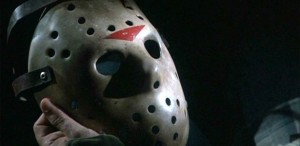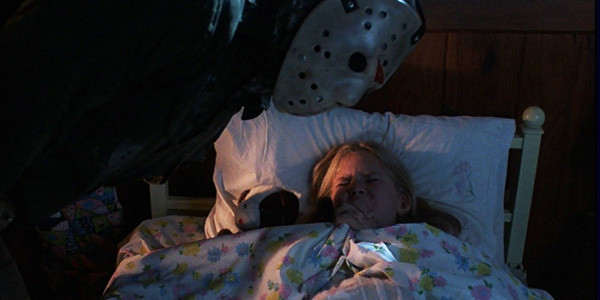
1990’s MISERY is a film about the creative process, and though the book at the center of the film is a bodice ripper rather than a horror story, it’s still a movie about the horror of one’s creation getting out of hand. Three years later, another Stephen King property, THE DARK HALF, dealt with a writer’s own pseudonym coming to life and killing anyone who’ll stand in the way of “his” writing more books, after the author outs himself and decides to begin publishing under his own name. 1992’s CANDYMAN, 1994’s IN THE MOUTH OF MADNESS, and 1997’s URBAN LEGEND are horror stories about horror stories, while WES CRAVEN’S NEW NIGHTMARE is a horror film about other, real-life horror films.
Call it a side effect of Gen X’s jadedness: traditional storytelling was too sincere for them. They wanted conventions subverted and tropes dismantled; they wanted media that was acutely aware that they were acutely aware of it. The result was a decade of horror unlike any that had come before, both giving us fresh new takes on the genre and impacting the way that films were made and consumed for years to come—I mean, seriously, go read an interview with any horror director or writer and count how many times someone talks about “subverting tropes” or “genre conventions.” I’m guilty of it myself. What’s not readily apparent when analyzing the 1990s love of meta-horror, though, is that the trend has its roots in two 80s properties that knew which way the wind was blowing: FRIDAY THE 13th PART VI: JASON LIVES, and a lesser known—but no less prophetic—film called I, MADMAN.

Strange as it might seem, it was, indeed, in a Friday the 13th film that Gen-Xers probably got their first taste of meta-horror. Not a series generally known for its depth or intelligence, JASON LIVES was written by Tom McLoughlin, a unique writer brought onto the series especially for his fresh perspective and insight. The previous installment, the infamous NEW BEGINNING, had alienated fans of the franchise by not featuring Jason at all, and Paramount wanted to make sure that they hadn’t accidentally cooked the goose who laid the golden machete. McLoughlin was known around Hollywood as something of an anomaly: A practicing Catholic in a city of atheists, he was just as comfortable writing disturbing horror movies as he was playful, family friendly comedies. In other words, he was unpredictable and knew how to give something to everyone—the perfect choice to breathe life into a dying series in a dying subgenre. That’s exactly what he did, too. JASON LIVES differentiated itself from the rest of the series by explicitly differentiating itself from the rest of the series. While the previous entries were dark and mordant, McLoughlin infused it with a sensibility that was half Universal Monster movie, half rock-and-roll stage show. Where the earlier films were sleazy and dark, this was fun and kinetic. Most importantly, while parts 1-4 were naïve entries in the slasher canon, McLoughlin decided to use the film as a vehicle to look at the course horror had taken in the 80s. Though it seems pat today, when the character Lizbeth (played by McLoughlin’s wife, Nancy) turns to her boyfriend and begins explaining to him how to behave in a horror movie—in a horror movie—it was something unlike anything audiences had ever seen.
It was the opening salvo in a film that subtly acknowledged exactly what it was, and welcomed everyone watching it to do the same. Martin, the gravedigger, breaks the fourth wall and questions why the Friday the 13th series is popular in the first place; Jason becomes fixated on a little girl named Nancy wearing a white night dress, an explicit call-out to the then-recently released NIGHTMARE ON ELM STREET; the film ends with Alice Cooper performing a song called He’s Back, reassuring audiences that Jason is here to stay as the series’ villain. (In a subtler nod to the coming of the 90s, the counsellors are dressed in weirdly prescient clothes from washed-out denim to plaid flannel that accurately predicted many of the next decade’s biggest trends; McLoughlin simply saw which way the wind was blowing and wanted his kids to look fashionable). In many ways, JASON LIVES is a subtler version of Scream that’s less observational but perhaps a bit more honest; indeed, McLoughlin was an early choice to direct that film before Wes Craven came on board. In what must be one of the ballsiest moves in the history of horror cinema, McLoughlin turned down the job because “I already made this movie. It was JASON LIVES.”

JASON LIVES, of course, had the benefit of being an entry in a hugely successful franchise put out by a major studio. A bit more off the radar—but no less prophetic—I, MADMAN debuted in 1989 to little fanfare, and had virtually nothing going for it. The biggest name in the cast was Jenny Wright, who’d made a minor splash two years prior in NEAR DARK but whose star was on the decline amidst personal issues; writer David Chaskin, despite his talent, was on the horror world’s collective shit list for authoring A NIGHTMARE ON ELM STREET 2; and director Tibor Takács, though having earned a small cult following for 1987’s THE GATE, wasn’t exactly a household name. It had everything going for it to debut to theaters, make a small amount of money, and then disappear into the trenches of the bottom shelf at Blockbuster, which is more or less exactly what it did. Those who saw it, though, were in for a treat—it wasn’t just an enjoyable little potboiler, it was an opening salvo in the 90s’ obsession with horror media about horror media, and the implications of consuming it.
Wright stars as Virginia, who might be the most quietly progressive heroine of 80s horror cinema. She’s neither a helpless, shrieking mess nor a glorified sex object, and she’s got a pretty egalitarian relationship with her cop boyfriend, though he’s dumber than a box of rocks. Startlingly for a female 80s horror protagonist, she has her own personality and interests, most of which run along literary lines: she’s a big fan of obscure, gritty genre pulp, and uses her position at a second-hand bookstore to avail herself of the stuff no one has ever heard of and which few people will ever come looking for. Her latest acquisition is a particularly nasty tale called I, Madman, a morbid proto-gialli from the EC Comics school. Its villain protagonist is an insane surgeon named Dr. Kessler, who becomes obsessed with beautiful actress Anna Templar. In Kessler’s diseased mind, the way to her heart is to murder everyone closest to her and then surgically add pieces of their faces to his own. Virginia is rapt with the story, though she’s not entirely sure why she’s so fascinated by something that’s much more disturbing than her usual brand of horror. Compelled to read the rest of the authors’ works, she makes an unsettling discovery: He only published one other book before being committed to a mental institution. In seeking out the second book, Virginia appears to open some sort of rift between the literary world and the real one: Dr. Kessler springs to life from the page, and begins playing out I, Madman’s sick tragedy with Virginia in the unwitting role of Anna Templar.
It’s easy to see why I, MADMAN didn’t make a bigger splash. It’s a niche film to begin with, dropped in a year where horror had begun to make a shift into more overt audience-friendly camp with flicks like PUPPETMASTER, A NIGHTMARE ON ELM STREET 5, JASON TAKES MANHATTAN, THE BURBS, GHOSTBUSTERS 2, and SWAMP THING (to say nothing of the abominable HALLOWEEN 5). While the premise (and Wright’s performance) could have pushed it to a more solid cult-status if it’d been explored more thoroughly, horror creatives were still just dipping their toes into the waters of metacinema and clearly playing it cautious. For the first two thirds of its running time, I, MADMAN is a thing of rare beauty. It has a competent, interesting female protagonist and a unique premise. At the tail-end of a decade obsessed with stalk-n-slash films, it asks the pointed question of why seemingly average people like insanely gruesome stories, as well as what sort of mind it takes to create such media in the first place. Kessler makes a creepy villain, and the sequences involving him are genuinely upsetting, even if they never quite venture into the darker-than-dark territory implied by Virginia’s reactions to the source material. As the film draws to a close, though, things become too rushed, moving the audience into a climax that feels perfunctory and abrupt, and never brings the story around to a clear thesis. It’s fine if a movie asks questions that it lets the audience answer for themselves, but those questions need to be more fully articulated if that’s the tack you’re going to take; I wouldn’t be surprised to learn that some executive meddling was responsible for the abrupt tonal and pacing shifts that define the last portion of the movie. Still, those first 2/3 are worth it, especially from an academic perspective—while McLoughlin may have jokingly asked why people like horror, it was in Chaskin’s hands where the question first became serious. In many ways, it’s a question we’re still asking today; and even if the film doesn’t give us any answers, it’s a fascinating glimpse at a surprisingly mature step in the evolution of horror at a time when the genre seemed to be in a state of permanent arrested development.


No Comments